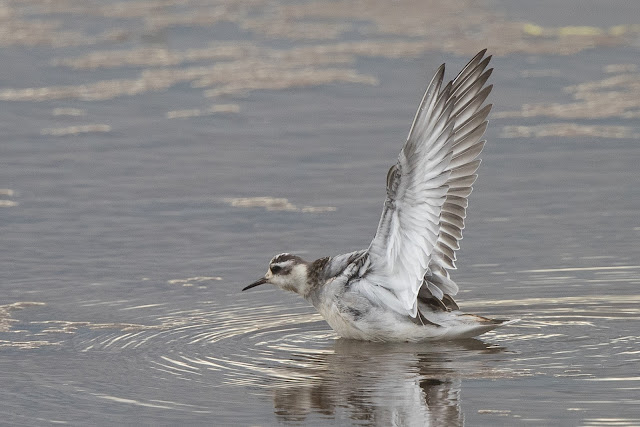Dawn over Pennington Marsh
Three of the four Black Swan
Scanning across the marshes I picked up a distant Whinchat and a Wheatear. I decided to turn east and head through the Bramble scrub along the southern bank of Butts and Jetty Lagoons hoping for a Wryneck but it was pretty birdless. Scanning over the now cut marshes to the south of Shoveler Pools there were at least 150 Meadow Pipit that had been put up by a passing Kestrel. Wandering out to the seawall I turned east for a short way to scan Pennington Lagoon but there was little here. Scanning to sea produced seven Sandwich Tern and a large flock of perhaps 500 Black-headed Gull feeding offshore. A passage of hirundines eventually picked up with around 350 House Martin, 20 Sand Martin and 50 Swallow moving east. There were still small numbers of Yellow Wagtail with three moving west over this morning. On Jetty Lagoon there were 55 Black-tailed Godwit and 68 Teal, it was feeling remarkably slow and I began to think I might be home early. On the seawall a small flock of eight Yellow Wagtail were showing nicely and I spent a little time watching them although they remained too distant and flighty for any photos. Approaching Butts Lagoon I picked up a small wader in flight and knew immediately that it was a Grey Phalarope, it flew towards me and dropped below the reedline on the southern edge of Butts Lagoon so I changed my angle to get a view along the reedline but by the time I had walked along the seawall it was nowhere to be seen. I put the news out on the Hampshire birding text system and within about 15 minutes I could see Steve Piggot marching along the seawall but at this stage I had not relocated the bird. Steve and I then spent at least 30 minutes looking for the bird but with no luck and we concluded that the bird must have flown. Splitting up, I had only walked a short distance before I heard Steve shout that he had refound it and as I ran back to him I expected to see the bird spinning on the lagoon but Steve had lost it when he had turned to shout to me. We started scanning with no sign of the bird and once more split up. After a further 20 minutes or so I refound the bird where Steve had seen it and watched it for 30 seconds before it flew several hundred metres out into the Solent. I rejoined Steve to find that he had also been watching it on Jetty Lagoon. This was a flighty bird that had clearly just arrived and unfortunately I didn't manage to take any photographs.
We wandered on past Fishtail lagoon where the three Spoonbill were showing well. A scan back out to the Solent produced a small flock of perhaps 15 'Commic' Tern and scanning through we found at least three juvenile Arctic Tern while all the other birds appeared to be Common Tern. A flock of around 50 Black-headed Gull on Fishtail Lagoon also contained an adult winter Mediterranean Gull, a Sandwich Tern and a Common Tern. Keyhaven Lagoon supported a small flock of around 30 Dunlin but little else so I decided to head off.
Adult Winter Mediterranean Gull with Black-headed Gull
Above images all of the Grey Phalarope at the north end of the Billy Line, Hayling Island. This is a 1st winter bird with dark juvenile feathers retained on the head and upper parts

















